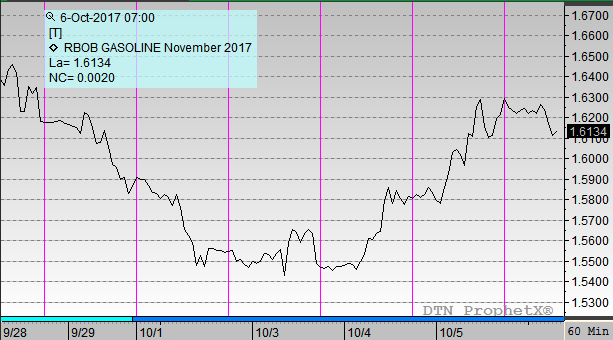
Week in Review
This week has been an interesting show for sure. Crude oil prices trended generally downwards, dipping below $50 on Wednesday, then shooting up to weekly highs above $51 on Thursday. Prices moved from $49.76 to $51.22 in just a day, a 3% price movement. Prices are down 1.7% between Monday’s opening price and today’s opening price.
As we mentioned in yesterday’s article, crude days of supply have risen in recent weeks while refining capacity has been offline. Crude exports have soared to record levels, driven by excess supplies in the U.S. and strong spreads between WTI (U.S.) crude and Brent (international) crude prices.
Despite the weak fundamentals, crude staged a rally on Thursday as OPEC shook the market awake with calls for production cut extensions and additional members capping production. Russia indicated that the deal could be extended until the end of the year, and up to 16 countries have been mentioned as candidates for being added to the deal. Markets have grown comfortable with the OPEC deal as it currently stands, so additions or extensions would almost certainly send markets higher.
Diesel prices have weakened slightly this week, though they remain elevated. Diesel prices averaged $1.53 in July, $1.63 in August, then jumped to average $1.79 in September. Given how quickly diesel prices rose, some minor price corrections are a natural reaction, and should not necessarily be read as a downward trend in the market. Prices have varied by 4% this week, going from a weekly low of $1.7382 on Wednesday to a weekly high of $1.8127 on Thursday. Overall, prices are only off 1% from their opening price of $1.81.
As Wednesday’s EIA data showed, diesel supplies still are not keeping up with demand, and inventories are being drawn down rapidly. Diesel inventories are just 10 million barrels (MMbbls) above their 2012-2015 average, down 21 MMbbls from this time last year.
Part of the problem is remnant supply shortages from Hurricane Harvey. While affected areas are now normalizing in supplies, the ripple effect from those outages will certainly continue to be seen in refined products in the near future. Diesel crack spreads, the difference between crude oil and diesel fuel (processed through a cracking unit at a refinery) remain elevated, sending a signal to refineries that their supply is not keeping up with demand. Days of diesel supply reached a 2017 low this week at 33.7 days, slightly below the 10-year average of 35 days of diesel supply.
Gasoline prices tracked relatively close to diesel movements. Prices began the week low, bouncing off $1.5421 on Monday, and rising to a high of $1.6330 on Thursday, a range of 3.5%. Overall, gasoline prices are up 2% this week, in contrast to crude and diesel’s losses. The gains in gasoline are surprising, given the reported stock build this week. Days of gasoline supply have risen slightly, up from its low during Hurricane Harvey but still below 10-year averages.
As we mentioned in last week’s weekly review, gasoline prices have been subject to changes in RINs markets. The EPA last week announced that they were considering changes to the renewable volume requirements in the U.S., which caused RINs to plummet in value. This week, Platts reported that opposition to the EPA’s proposed change has helped give RINs a boost, translating into higher gasoline market prices.
This article is part of Uncategorized
Tagged:
MARKET CONDITION REPORT - DISCLAIMER
The information contained herein is derived from sources believed to be reliable; however, this information is not guaranteed as to its accuracy or completeness. Furthermore, no responsibility is assumed for use of this material and no express or implied warranties or guarantees are made. This material and any view or comment expressed herein are provided for informational purposes only and should not be construed in any way as an inducement or recommendation to buy or sell products, commodity futures or options contracts.








